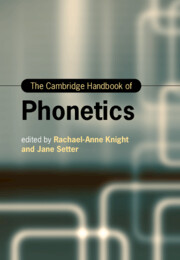Book contents
- The Cambridge Handbook of Phonetics
- Cambridge Handbooks in Language and Linguistics
- The Cambridge Handbook of Phonetics
- Copyright page
- Contents
- Figures
- Tables
- Contributors
- Introduction
- Section I Segmental Production
- 1 Physiological Foundations
- 2 Vowels
- 3 Consonants
- 4 Coarticulation
- 5 Processes in Connected Speech
- Section II Prosodic Production
- Section III Measuring Speech
- Section IV Audition and Perception
- Section V Applications of Phonetics
- Index
- References
2 - Vowels
from Section I - Segmental Production
Published online by Cambridge University Press: 11 November 2021
- The Cambridge Handbook of Phonetics
- Cambridge Handbooks in Language and Linguistics
- The Cambridge Handbook of Phonetics
- Copyright page
- Contents
- Figures
- Tables
- Contributors
- Introduction
- Section I Segmental Production
- 1 Physiological Foundations
- 2 Vowels
- 3 Consonants
- 4 Coarticulation
- 5 Processes in Connected Speech
- Section II Prosodic Production
- Section III Measuring Speech
- Section IV Audition and Perception
- Section V Applications of Phonetics
- Index
- References
Summary
Vowels are traditionally viewed as one of the two major classes of speech sound. Vowels lack contact between the tongue and the roof of the mouth, and they are normally voiced. Importantly, the speaker receives little proprioceptive feedback from their speech organs, meaning that it is not fully appropriate to define a vowel in terms of place and manner of articulation. Instead, tongue height and advancement are used to describe vowel quality, and auditory features play a more important role in description, e.g. with reference to the Cardinal Vowels system. Vowel categories form a continuum, and this has repercussions in terms of articulatory, auditory and acoustic overlap between contrastive categories and the special role that vowel gradience plays in dialect variation and language change. Other features of vowels stem from the general openness of vocalic articulations. For example, in principle, lip rounding can be combined with any tongue position, and nasality too demonstrates specific patterns that have both phonetic and phonological dimensions. Vowel quantity, or duration, is also used in differing ways by different languages, both phonemically and allophonically.
- Type
- Chapter
- Information
- The Cambridge Handbook of Phonetics , pp. 40 - 64Publisher: Cambridge University PressPrint publication year: 2021
References
2.7 References
2.7.1 Online Resources
- 1
- Cited by



